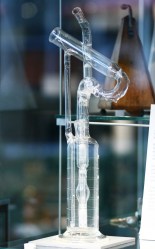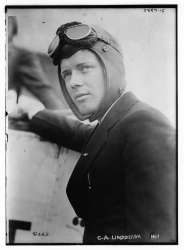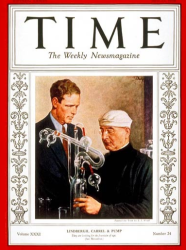Most people remember Charles Lindbergh for his non-stop solo flight across the Atlantic which made him an international celebrity. If you are a student of history, you might also know he was at the center of a very controversial trial surrounding the kidnapping of his child or even that he had a dance named after him. But did you know he was also the co-inventor of a very important medical device? Turns out, medicine can thank Lindbergh for the creation of the perfusion pump.
The What?

A perfusion pump is a device that allows organs to be sustained outside the body using oxygenated blood or a suitable analog. A researcher, Alexis Carrel, had the suitable analog fluid and was convinced that he could keep organs alive in vitro, but was unable to devise a pump mechanism. Lindbergh was up to the mechanical challenge and, with Carrel, invented the machine in 1935.
While they didn’t become medically important themselves, they were the precursor to things like a modern heart-lung machine that has saved countless lives. At the time, many thought Lindbergh might be more famous in the future for this invention than his transatlantic flight. But today not many people remember his medical invention.
Why Lindbergh?
If it turned out Lindbergh invented some device for pilots, that wouldn’t be very surprising. But why a perfusion pump? The story goes back to when his sister-in-law suffered heart damage from rheumatic fever. Doctors said the damage was irreversible because the heart couldn’t survive long enough without pumping to allow for the surgery necessary.
Of course, Lindbergh was well known for challenging what could and couldn’t be done and he wondered why a machine couldn’t keep the heart alive. No one seemed very interested in the idea until he mentioned it to an anesthesiologist, Palulel Flagg, who knew that Carrel was working on the very thing.
The Partners
 Carrel was, by all accounts, an odd fellow. But if Charles Lindbergh wanted a meeting, you took it. The day after Lindy found out about Carrel, they met at his lab where there had been two unsuccessful attempts at constructing a pump already.
Carrel was, by all accounts, an odd fellow. But if Charles Lindbergh wanted a meeting, you took it. The day after Lindy found out about Carrel, they met at his lab where there had been two unsuccessful attempts at constructing a pump already.
Lindbergh had some ideas and working with a glass blower, produced a prototype. Carrel was impressed and offered space in his lab. However, Lindbergh’s fame was a constant problem and despite efforts to keep his work low-key, people were all anxious to meet the famous flyer.
Carrel had already won the Nobel prize for essentially inventing vascular surgery. He also pioneered the use of chlorine to wash out wounds, a great advance before antibiotics were available. He was a bit eccentric, insisting his lab assistants, for example, always wear black and, apparently, held some occult beliefs. He died awaiting trial in France for being a Nazi sympathizer after World War II.
Trial and Error
 There were two key problems: circulation and avoiding bacterial infection. Lindbergh produced one prototype that wasn’t perfect, but did keep a carotid artery alive for a month. In 1931, Lindbergh published his results unsigned.
There were two key problems: circulation and avoiding bacterial infection. Lindbergh produced one prototype that wasn’t perfect, but did keep a carotid artery alive for a month. In 1931, Lindbergh published his results unsigned.
By 1935, the device was near perfection. The device was glass and could be made sterile in an autoclave. Sterile cotton filtered the incoming air. There were three chambers: the top one contained the organ in question. The lowest chamber held the perfusion fluid. Gravity pulled the fluid down until the liquid was back where it started.
However, the fluid had no where else to go and, unlike a human body, there was no kidney to clean everything up. This required frequent changes of fluid which invited contamination and threatened the sterility and stability of the system.
In 1935 the pair kept a cat organ alive for over 18 days. The news was so impressed that they wound up on the cover of Time magazine. We don’t know if Time was impressed with the invention or with Lindbergh’s involvement, although you can assume it was a bit of both.
However, the press became sensational and soon stories were circulating that Carrel was growing embryos and that Lindbergh was growing himself a new heart. Carrel clearly had used Lindbergh for his publicity value, but this started to backfire.
Perfusion Today
Both men fell into scandal around World War II and work on the perfusion pump stopped. By 1950, interest in keeping organs alive during surgery renewed and better methods were found. But it was Lindbergh and Carrel who paved the way for things like open heart surgery and even organ transplants with their miraculous perfusion pump.
Organ transplants have come a long way, and your next organ might come from a porker. Or maybe it will come from a 3D printer.















I first read “perfusion pump” as “diffusion pump” and though that is an important bit of scientific equipment to just casually invent and not be known for. Though, writing this, I have no clue who actually invented the diffusion pump either….
Though, knowing the names of the various inventers behind various things is frankly mostly useless trivia most of the time. Especially such old inventions.
until you have to rebuild a society from old books.
Making certain one doesn’t break their glasses.
But I don’t need to know who invented X for me to understand what X is and what it does, or even how it works.
The name of the inventor and their background is frankly just pointless trivia most of the time.
Though, I can see advantages in being able to faster find other useful inventions if one can track it through the person behind the inventions or their acquaintances.
But it is likely far more efficient to categorize inventions by what they do and what other inventions are related to it and what other inventions it is dependent on or in turn is a dependency of. Or of alternative solutions fixing the same problem. For this the name of the inventor is yet again not an important factor.
I sort of agree, it IS more important to know the information (as quickly as possible) rather than the originator’s name(s). The INFORMATION is paramount.
Also, I would say that it’s good to know a little bit about the inventors that seeded our need for knowledge. They made our lives easier.
I agree and would add that knowing some biographical details e.g. about the thinking and the development process involved in the invention, where he found his inspiration and motivation, who he went to for help, even the part that mere chance or luck played in the final result, can be important and useful for today`s would-be inventors.
Best regards,
A/P Daniel F. Larrosa
Montevideo – Uruguay
A Canticle for Liebowitz??
As long as they do it for *Emma”…
1915, Wolfgang Gaede [1], [2]. Ain’t Wikipedia wonderful?
Now thank you for sending me down the rabbit hole. Oh, I have work to do, damn!
[1] https://en.wikipedia.org/wiki/Diffusion_pump
[2] https://en.wikipedia.org/wiki/Wolfgang_Gaede
Let’s also not forget Lindbergh was a racist and fascist, and also had seven out-of-wedlock children with three different women. A nice person he wasn’t…
“Both men fell into scandal around World War II” really fails to convey that detail!
And your point is?
Sounds just like any number of current day “celebrities”
Just replace fascist with Marxist.
I was thinking of actors and musicians primary who father children far and wide . I am not familiar intricacies of the American political spectrum.
Though I understand republican and Democrat are the names of your major political flavors
Nobody’s saying we should be like him, just that he made at least one important thing for the sake of humanity.
Just like the chemist that developed an mass production-able synthesis process to produce huge amounts of nitrogenated fertilizer, just for his invention to end up killing a hell lota people by being a great component for explosives. Man did end up enabling mass destruction, and also enabled farmlando productivity to skyrocket and increase food accessibility throughout the planet. He did a amazing thing, just don’t follow his path.
I think you’re referring to Fritz Haber, but don’t sell the man short, he was also regarded as the “Father” of chemical warfare. (Talk about a guy who needed a condom!)
https://en.wikipedia.org/wiki/Fritz_Haber
Yeah, the man was a nasty boy
What does having children with several women have to do with anything? Seriously, keep your strange sexual/relationship morals out of this. Puritan views are highly toxic and closely related to the mindset of racism.
ive tried to search biography of Palulel Flagg but google corrects its to Paluel Flagg.
Same person, different spellings, both seem to be used all over, but Paluel brings up more relevant results.
It I guess most of you are under 30 . I think you all miss the point. Many inventors if you read history we’re not nice people . The point is what gave the insentive to make the inventions. Think how easy it has made your life easier. Punch cards were invented to automate the garment industry in the late 1700. If someone didn’t invent computers there would be no hackers.
Most inventors did not try to align the US with a nation and ideology which would exterminate 1/3 of non combatant Jews because of who they were born to in the world as well as millions of soldiers and civilians in nations they tried to conquer. Under a Lindbergh guided fascist regime ousting FDR the US might have participated in making that 2/3 or more considering the industrial might and safety of the US as well as crushing the Allies.
It is unfortunate that HAD deleted my first response, I will say it again HAD profiling women and minorities in tech is a positive thing I hope continues, we can do without honoring a personal friend of the evil Nazis even if he won the race to cross an ocean or had something to do with a niche perfusion pump.
FWIW I asterisked the f-word before fascist in my first comment when this story was posted, because there is no polite way to describe the forces who murdered my whole family in Europe without a single remnant except those of us in the US and Canada, Lindbergh was their friend.
But Lindbergh isn’t here for the racism.
There’s this big focus right now on the evil of the past, but it’s going to be there for so many. There is a distinction between statues of people because they were racist, and statues of people who did something good, but were also racist.
My great, great, great grandfather wrote three books, and some of it is racist. In part a reflection of the time, from somethi g else Iwonder if he was pandering to his audience. But he also wrote some neat things about Native people, and he knew one intimately.
How does pulling down a statue tell the story of my family, in an important event, but which has been erased? That story reframes the past. How does pulling down a statue fix police abuse, something I’ve experienced for my own reasons and can remember when it wasn’t a cause.
The past was racist. How do we fix the now, how do we fix the future? Racism isn’t about something someone else does, it’s not just people spewing hate. We are all capable of it, but it’s subtle.
I was born 90 years after the Red River Resistance, on the day after Louis Riel’s birthday. Which makes me 62 in October. The “old” aren’t indifferent, we just see the means differently.
I fail to see why censoring the past would bring anything positive with it. What happened was a waste of life. One can debate the issue ad nauseam and never reach an agreement on the issue. Personally, if something good came out of all the inhuman experimentation I would see that as at least something positive, eg. one childs life saved, one persons quality of life improved. At least then, they didnt die for nothing. In my mind, a death giving something positive for someone is vastly preferable to people dying pointless deaths for nothing. And as far as i know Lindbergh never killed anyone, he had a political view that nowadays is deemed incorrect. In context, bearing in mind the time when his invention was made, he deserves to be mentioned. Beside the point, perhaps, but I fail to see why gender or being a part of a minority should play any role in scientific research/discovery. The merit is that of the entity, not its gender, ancestry or sexual orientation.
To both you and Michael Black above.
Hackaday is a DIY hacking website, and they sometimes do bits about deserving inventors as a side thing; especially women lately, which is super cool.
I am not saying to delete Charles the Nazi friend from wikipedia or history books, but as interesting as his pump might be it is not worthy of a great website to sully itself holding up a proponent of genocidal white nationalist world rule. Adolf the genocider was very clear from the 1920s on about his genocidal plans for Jews and Slavs among others, Charles their friend, as in he went to hang out with Goring a year before the war had his chance to be a normal baseline racist American in the 30s and 40s and not side with literal Nazis.
If HAD is going to do side bits don’t feature Nazis with a single sentence about unnamed controversy, feature interesting hackers of merit especially from underrepresented groups.
As for never killing anyone I am not sure if even most of the top Nazi leadership ever killed anyone with their own hands, Lindberg never got his chance as Americans rejected his extreme antisemitism.
Read the cited passages about Lindberg and the outrage normal people had about his racist extremism in his time in the wikipedia article and reconsider your posts.
https://en.wikipedia.org/wiki/Charles_Lindbergh
This feature while well written is a dark spot on HAD’s reputation featuring a guy so bad he was cancelled in 1940s USA and became unimportant to normal Americans of the time.